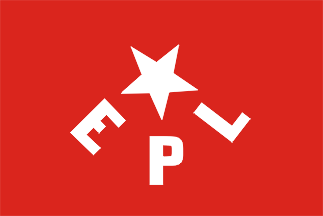
Original EPL Flag
image by Jaume Ollé

Last modified: 2008-07-19 by dov gutterman
Keywords: colombia |
Links: FOTW homepage |
search |
disclaimer and copyright |
write us |
mirrors
Editorial Remark: It must be noted that all the opinions are of the authors and not of FOTW. Our site is non-political and concentrates only on vexillological issues.
See also:

Original EPL Flag
image by Jaume Ollé

New EPL Flag
image by Eugene Ipavec, 29 July 2007
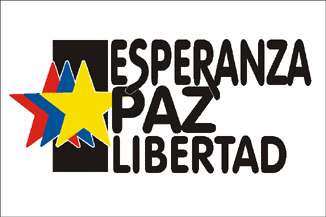
Esperanza, Paz y Libertad (Old Flag)
image by Jaume Ollé
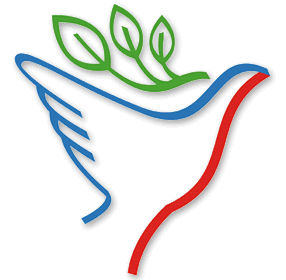
Esperanza, Paz y Libertad (New Logo)
image by E.R., 23 March 2005
From <www.tkb.org>:
Mothertongue Name: Ejército Popular de Liberación (EPL). Base
of Operation: Colombia.
Founding Philosophy: The Popular Liberation Army grew out of the
Colombian Communist movement of the 1960s. In 1967, the
Marxist-Leninist Communist Party (ML-CP) broke off from the
larger communist political party, the Colombian Communist Party.
Dissatisfied with the political chaos of 1960's Colombia, the
ML-CP augmented its political organization with an armed wing in
1967. The new group soon embarked on terrorist activities under
the name People's Liberation Army. Both the ML-CP and EPL
advocated the Maoist ideology of sparking a national socialist
revolution by beginning in the countryside. Efforts to
indoctrinate the peasantry largely failed and the EPL never
reached the size of larger Colombian terrorist insurgencies such
as the FARC and ELN. In an effort to expand their support base,
the EPL abandoned strict Maoism in 1980. The group continued,
however, to work toward the goal of overthrowing the
democratically elected Colombian government and replacing it with
a communist state. Furthermore, the EPL continued to pursue these
insurrectionist goals through terrorist activities.
Current Goals: The EPL was one of the principal groups that
pushed for a peace accord with the Colombian government in the
early 1980s. With the signing of the peace accord in 1984, the
EPL attempted to join mainstream Colombian politics. Their
efforts were blocked, however, by the newly formed right-wing
paramilitary groups, such as the ACCU. In an effort to derail the
efforts to grant the politicization of the EPL, the right-wing
paramilitary groups attacked political representatives of the
EPL. The peace accord soon unraveled as other leftist groups, the
paramilitaries, and the Colombian Army continued their attacks on
one another.
Following the failure of the peace accord, the EPL attempted to
rejoin the violent fray involving the guerillas and Colombian
security forces, but this attempt proved futile. The EPL
essentially disbanded in 1991, when it signed a truce with the
Colombian government, although a breakaway faction operating
under the same name refused to accept the truce. This breakaway
faction continues to operate today, despite the arrest of its
co-founder and principal leader, Francisco Caraballo, in 1994.
I reccomend you read the article on wikipedia
to understand the flags.
E.R., 23 March 2005
EPL had lost political protagonism over the years and it is
basically only active in the North Eastern region of the
Department of Antioquia known as
Urabá.
More information on Hope, Peace, and Liberty (Esperanza Paz y
Libertad) at wikipedia.
E.R., 12 August and 3 September 2007

image by Eugene Ipavec, 17 July 2007
Horizontal blue-white-red. Similar colors to M19 Guerilla Movement flag. Source is
Smith (1975) [smi75a], pp.
340-341 ("Symbols in politics"). Smith says that these
are real flags and not only party emblems, which may differ in
colours when used as emblem or in a flag.
Ivan Sache, 6 August 1999
ANAPO (Alianza Nacional Popular, People's National Alliance)
was founded by Lt. General Gustavo Rojas Pinilla in 1961). The
ANAPO lasted more than three decades, gaining importance on the
State and Local level as well, but it ceased to exist in 1998.
Many of its members are now part of the PDI
(Polo Democrático Independiente).
Flag appears at Registraduría's
official website.
E.R., 17 July 2007
In 1984 a new guerrilla group emerged in Colombia: the
Movimiento Armado Quintín Lame (Quintin Lame Armed Movement),
named after a NASA tribe leader (Manuel Quintín Lame Chantre),
it was a guerrilla group, thus an illegal armed organization. It
entered peace talks with Colombia's government and laid down its
weapons in May 1991.
E.R., 23 March 2005

image by Eugene Ipavec, 25 October 2005
The flag of the ERP (Ejército Revolucionario del Pueblo, or
Revolutionary People's Army), a breakaway faction of the ELN. The ERP was formed in 1996. The
lettering style is the same as the ELN, only the color scheme is
different.
Source: <www.geocities.com/ta-erpkomm.html>.
E.R., 25 October 2005
In recent news, the ERP has fully demobilized on April 30,
2007 as stated by the Minister of Defense of Colombia. This day,
the last 18 combatants from this ELN
breakaway independent faction demobilized after starting military
actions in August 10, 1996. The total number of demobilized
illegal armed fighters, including the last 18, is 54 during the
whole month of April, in a series of multiple demobilizations.
The faction operated in the Municpalities of San Jacinto,
Maríalabaja, El Carmen de Bolívar, San Juan Nepomuceno, located
in the Department of Bolivar and the
Municipalities of Ovejas, Chalán, Colosó and Las Palmitas,
located in the Department of Sucre.
Among the combatants are 16 women and two newly born children.
This demobilization process took place in part due to the
pressure of the Army, but also from the FARC,
another guerrilla force who is battling other guerrillas (i.e.
the ELN ) in order to gain superiority.
Sources: La FM
adiostation, El
Tiempo newspaper, Military
Forces General Command, Semana
magazine.
E.R., 9 June 2007
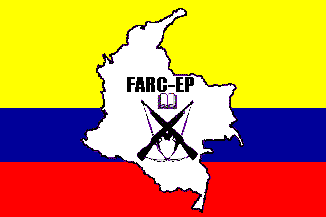
image by Pascal Gross and Guillermo Aveledo, 3
June 2000
.jpg)
Emblem
image contributed by E.R., 24 July 2005
I found the official site of the FARC guerrilla group on the
web, and you can see their flag. It's the same as the colombian
flag, but it has a Colombian map along with two assault rifles
crossed . There's also a little squared thing, but I can't see
much. The link to it is <burn.ucsd.edu/~farc-ep>.
Their official name is: Fuerzas Armadas Revolucionarias de
Colombia-Ejército del Pueblo (FARC-EP) or Revolutionary Armed
Force of Colombia-People's Army. The guerrilla group known as
FARC-EP was created in 1964.
Ramiro Rivera Sanchez,19 January 1999
I belive that the" little squared thing" is an open
book.
Jorge Candeias,20 January 1999
Revolutionary Armed Forces, People's Army (FARC-EP Fuerzas
Arnadas Revolucionarias de Colombia - Ejercito Popular) - This
well-known guerrilla group is the main guerrilla movement in
Colombia, above from the National
Liberation Army (ELN). The flag of the FARC-EP is a regular
Colombian tricolor with the group's logo on its centre. The logo
consists of a Colombiam continental map, in white, fimbriated in
black. Within the map we see the letters 'FARC-EP' in a bold
type, an open book and a pair of crossed, semi-automatic, rifles.
Guillermo Aveledo, 3 June 2000
The correct name of the movement is: Fuerzas Armadas
Revolucionarias de Colombia - Ejercito del Pueblo. A short
presentation of the FARC, based on Courrier International
#711, 17 June 2004 (French translation of a paper by Eduardo
Pizarro Leongomez, originally published in El Tiempo,
Bogota): On 9 April 1948, the Liberal leader Jorge Eliecer
Galtan was murdered, which triggered violent riots in Bogota,
known as Bogotazo. The next ten years are known as the Violencia
period, a civil war between the Liberals and the Conservatives
that caused more than 200,000 dead. In 1958, the two parties
signed the pact of National Front, by which they abandoned
violence and shared the power. The President of the Republic was
alternatively chosen in each party. The system lasted until 1974.
On 27 May 1964, the Colombian army attacked Marquetalia, which
was the headquarters of Communist revolutionaries and farmers'
self-defense militia, ruled by Manuel Marulanda, aka Tirofijo
(Bang on target). Following the assault, the militia were
organized into guerillas. Initially called Frente Sur (Front
South), the guerillas were renamed FARC two years later. The FARC
were reorganized and renamed FARC-EP in 1982. On 28 March 1984,
the FARC-EP signed an agreement in La Uribe with the
Colombian government. A cease-of-fire was implemented on 28 May.
The agreement included the creation of a legal political party by
the FARC-EP, called UP (Patriotic Union). More than 3,500 members
of the UP were murdered in the next two years, including two
candidates to the Presidential election. In December 1990, the
bombing of the Casa Verde, the FARC-EP headquarters, by
the Colombian army ended the peace process. A new round of
negotiations started on 7 January 1999 between the FARC-EP and
Andres Pastrana's government in the demilitarized area of Caguan
(42,000 sq. km). The area was placed under the control of the
FARC-EP until the breakdown of the negotiations in February 2002.
The FARC have today some 15,000-17,000 members.
FARC-EP homepage at <www.farcep.org>.
Ivan Sache, 27 December 2004
From <www.tkb.org>:
"Mothertongue Name: Fuerzas Armadas Revolucionarias de
Colombia (FARC).
Aliases: Fuerzas Armadas Revolucionarias de Colombia - Ejercito
del Pueblo (FARC-EP).
Base of Operation: Colombia.
Founding Philosophy: The Revolutionary Armed Forces of Colombia
(FARC) grew out of the Colombian Communist Party of the 1960s.
Unsurprisingly, the FARC was founded as a Communist organization.
The FARC leaned towards the Marxist strain of Communism and
received a limited amount of funding from the Soviet Union during
the Cold War. The FARC's stated goal is to overthrow the current
democratic government of Colombia and replace it with a Communist
government.
While the FARC is undoubtedly the largest and oldest of the
Communist insurgent groups of Colombia, it is not necessarily the
most dogmatic in its devotion to the Marxist ideology. In fact,
the FARC's growing hand in cocaine trafficking, and even
production, coupled with its on-again, off-again peace talks with
the Colombian government, indicate that the ideological backbone
of the FARC is at best, ill-defined. However, a significant
portion of the FARC's leadership, including FARC chief Manuel
Marulanda, have been part of the organization since its founding
and are presumably still dedicated to its Marxist ideology. The
FARC continues to wage a war of words devoted to Marxist
principles, despite the fact that many of its battles are fought
with the less idealistic motive of controlling the illicit drug
inustry.
Current Goals: Today, the FARC's primary goal is territorial
control within Colombia. The FARC has several sources for the
money it needs to pursue this goal. The majority of its funding
comes from the cocaine trade, but the FARC also pursues
kidnapping, extortion, and hijacking. In addition to these
operations, the FARC also attacks Colombian political and
military installations. Its activities frequently disrupt
economic activity in Colombia, particularly when conflicts with
Colombia's rightist paramilitary groups break out. Ordinary
Colombian citizens are often caught in the middle of this violent
and bloody struggle.
The FARC's larger goals are a matter for speculation. For four
decades the FARC has struggled to overthrow the Colombian
government. This does not seem likely unless the FARC
dramatically shifts its approach and increases its strength. The
more likely outcome is that the FARC will continue to destabilize
Colombian democracy but never actually overthrow the government.
Furthermore, the FARC's recent participation in peace talks
demonstrates a certain willingness to negotiate with its
ideological enemies. The FARC's ideological commitment is in
doubt, but its immediate goals are not. The FARC aims to maintain
its significant financial and territorial power. From all
indications, the FARC will continue its violent criminal action
for the foreseeable future."
More information at <en.wikipedia.org>.
E.R., 8 June 2005
1) 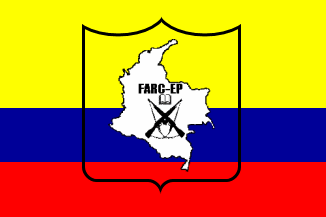
image by Eugene Ipavec, Pascal Gross and Guillermo
Aveledo, 14 February 2006
A photo of a variant
with shield of the FARC flag, appeared on the front page of
today's (29 June 2001) Miami Herald, with the headline
"Rebels Free Colombian Troops" and the caption
describing the release of "242 government soldiers and
police released Thursday by the Revolutionary Armed Forces of
Colombia [FARC] outside La Macarena, in the heart of a 26,000
square-mile area of jungle and savanna under FARC control. The
troops were freed by the rebels in a unilateral hand-over after
more than three years in captivity".
Al Kirsch and Jaume Olle', 29 June 2001
The variant is based on photos at FARC news
website and SEMANA magazine.
E.R., 14 February 2006
2) 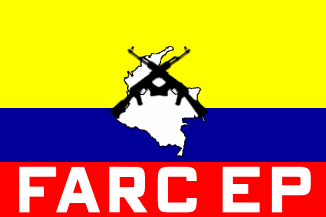
image by Eugene Ipavec, 17 March 2006
On March 8, 2006, the biggest demobilization yet (outside
peace process with the Colombian giovernment) of a guerrilla
group, took place on the Department of Tolima. There a FARC
guerrilla structure laid down its weapons on a ceremony headed by
the Alto Comisionado Para La Paz (High Commissioner For Peace).
During this ceremony a new FARC flag variant came to light.
Source: El
Mundo newspaper, from the city of Medellín.
E.R., 17 March 2006
3) 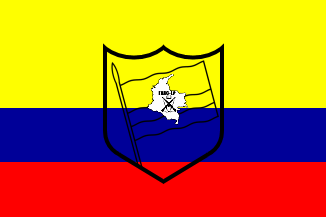
image by Eugene Ipavec, 27 May 2006
Another variant of the flag of the Farc Colombian guerrilla.
The flag is the same tricolor flag of Colombia, plus the Farc
emblem on the middle (outlined only, not in color).
Source: Farc 2006 calendar at <www.farcep.org>.
E.R., 27 May 2006
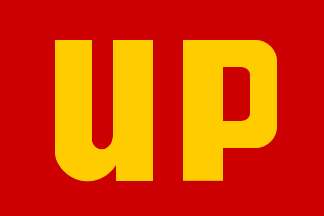
image by Eugene Ipavec (based on original by Jaume
Ollé), 3 September 2007
Unión Patriótica (UP- Unión Patriótica, or Patriotic Union
in English), was a political movement set up under the 1984 peace
talks between the Colombian government and the Farc guerrilla. The party was
established in 1985 and it was the Farc's official political
movement, with cadres from both the Farc and the Colombian Communist Party.
Some UP members even reached seats in Congress, as well as
important posts on the State and Local political level. However,
due to the extermination campaign by newly created paramilitary
forces as well as some official government action against this
party, it was diminished and it later faded away.
It officially ceased to exist under the new electoral code in
2006, but its members left or went underground much before that.
For more information on this party please refer to wikipedia.
E.R., 3 September 2007
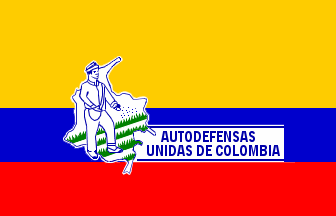
image by Eugene Ipavec, 17 July 2005

image by Eugene Ipavec, 17 July 2005

image by Eugene Ipavec, 17 July 2005
Name: United Self-Defense Forces of Colombia (AUC).
Mothertongue Name: Las Autodefensas Unidas de Colombia (AUC).
Aliases: United Self-Defense Group of Colombia.
Base of Operation: Colombia.
Founding Philosophy: The United Self-Defense Forces of Colombia
(AUC) was formed to combat the leftist terrorist organizations
operating in Colombia, primarily the FARC and ELN. The AUC grew
out of the paramilitary and self-defense groups formed in the
1980s. These groups were dedicated to protecting the economic
interests of wealthy citizens that were often threatened by
groups such as the FARC. The AUC is a nationalist group that
protects the Colombian government from the Communist-inspired
guerilla movements that threaten it. At first, the various
paramilitary groups enjoyed the tacit approval of the Colombian
military. The paramilitaries and the Colombian military
cooperated in the fight against leftist guerillas. Eventually,
however, the close financial connections between the drug cartels
and the paramilitaries forced the Colombian military to
officially sever ties with the paramilitaries in 1989. Despite
this, the military and the AUC have been accused of continuing
their collaboration unofficially, and many AUC members are former
members of the Colombian military.
The AUC is an umbrella organization comprised of independently
operated paramilitary groups. One of these paramilitaries, the
Peasant Self-Defense Group of Córdoba and Urabá (ACCU), is
thought to have spearheaded the formation of the AUC.
Furthermore, Carlos Castaño Gil, the co-founder and leader of
the ACCU, is recognized as the on-again/off-again AUC leader.
Current Goals: The AUC serves the interests of Colombian economic
elites, drug traffickers, and any local communities that do not
support the leftist rebels. According to the AUC, its primary
objective is to protect its supporters from leftist guerillas.
Clearly, however, the AUC is also keenly interested in
controlling the drug trade, which is its primary source of
earnings. AUC leader Carlos Castaño claims that 70 percent of
the AUC's operational costs are funded by drug-related sources.
The AUC is currently involved in peace negotiations with the
Colombian government. These talks, begun in July 2004, focus on
the disarmament of AUC blocks and their reintegration into the
Colombian Armed Forces in order to provide security in their
local strongholds. Like in past processes with Pablo Escobar's
group, the AUC is trying to negotiate surrender and disarmament
for a promise of non-extradition to the U.S. Despite AUC pledges
to work with the American and Colombian governments to take
action against cocaine production in the areas in which they
operate, the American government has refused to drop their
demands for extradition of AUC leaders. This has led to divisions
within the group and the slow progress of the talks. Analysts
believe that the decline in popular support for the AUC due to
the disappointing progress of the talks will lead to the
strengthening of the FARC and the ELN in areas once dominated by
the AUC.
Official AUC website: <www.colombialibre.org>,
Official AC-BCB website: <www.bloquecentralbolivar.org>.
Sources: <www.tkb.org>,
<en.wikipedia.org>.
A photo.
E.R., 1 July 2005
Flag 1: First version of the AUC flag (a peasant with a seed
bag sowing a field), with the name of the organization on the
middle of the flag of Colombia). This flag has been actually
flown on many events during the recent peace process between this
organization and the Colombian government.
Flag 2: Second version of the AUC flag (name of the organization
in black lettering on the top of the flag of Colombia). This flag
has been seen on aired TV interviews of top AUC leaders and also
on recent events during the recent peace process between this
organization and the Colombian government.
Flag 3: Third version of the AUC flag (initials of the
organization in white on green background). Attributed flag (I
first saw this image on <www.worldstatesmen.org>
a few years ago and I have also seen this image on Colombian
media coverage of the peace process: however I have not seen this
flag displayed).
For current news on the peace process between the AUC and the
Colombian government please reffer to "Alto Comisionado para
la paz" (High Commissioner fo Peace), official website: <www.altocomisionadoparalapaz.gov.co>.
The official website of the AUC is 'Colombia Libre' as the armed
movement called 'Los Pepes'. It is
believed that the AUC "core" emerged from 'Los Pepes',
as the flag of 'Los Pepes' bears the motto "Colombia
Libre" (Free Colombia), which is the AUC's website's name.
E.R., 18 July 2005
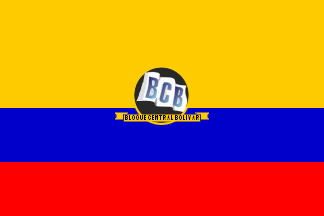
image by Eugene Ipavec, 12 July 2005
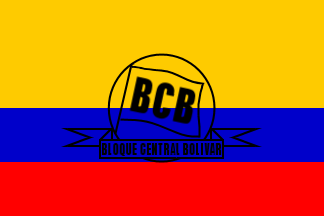
variant
image by Eugene Ipavec, 21 February 2006

"black variant"
image by Eugene Ipavec, 21 February 2006
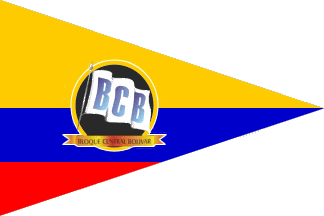
"pennant"
image by Eugene Ipavec and André Coutanche, 1
August 2005

"vertical pennant"
image by Eugene Ipavec and André Coutanche, 26
December 2005
.jpg)
Emblem
image contributed by E.R., 1 July 2005
The ACBCB (Autodefensas Campesinas - Bloque Central Bolívar,
or Peasant Self Defense - Bolivar Central Bloc) is one of the
main factions of the AUC umbrella organization. It is more
commonly referred to as Bloque Central Bolívar (Bolivar Central
Bloc, because it was established originally on the Department of
Bolívar but it has expanded tremendously to other remote areas
of the country).
E.R., 1 July 2005
The "pennant" is based on photo taken during a
ceremony of laying downof wepaons bu the Bloque Libertadores del
Sur, a "sub-bloc" of the much bigger ACBCB and is at
<www.altocomisionadoparalapaz.gov.co>.
The "vertical pennant is based on photo taken at the
demobilization ceremony of another structure of this paramilitary
force, on December 12, 2005 in the Municipality of Remedios,
Department of Antioquia as shown at <www.altocomisionadoparalapaz.gov.co>.
E.R., 1 August and 26 December 2005
The variant is based on photo at <www.altocomisionadoparalapaz.gov.co>.
This is another demobilization ceremony for this AUC faction.
This is the second part of the demobilization process. It was
held at the Municipality of Santa Rosa del Sur, in th Department
of Bolívar.
E.R., 5 February 2006
The "black variant" has a camouflage background, the
BCB emblem on the center. On the top it reads AUTODEFENSAS UNIDAS
DE COLOMBIA (in white) and on the bottom, beneath the emblem it
reads BLOQUE CENTRAL BOLIVAR, also in white.
Source: BCB variant at Demobilization ceremony of one of the
factions of the ACBCB. Picture taken on December 12, 2005 at the
Municipality of Remedios, Department of Antioquia and appear at
<www.surimages.com>.
E.R., 4 July 2006

image by Eugene Ipavec, 17 June 2006
.gif)
Emblem
image by Eugene Ipavec, 11 June 2006
the ACC (Autodefensas Campesinas de Casanare, or Peasant
Self-Defense of Casanare) named as such because they were first
established in the eastern plains of Colombia, in the Department
of Casanare. This group at some point was part of the AUC
confederation, but it broke away. When it was part of the AUC it
was called the 'Bloque Oriental' (Eastern Bloc).
In image at the newspaper El Tiempo (The Time,<eltiempo.terra.com.co>)
taken in the late 90's or early 2000, it shows the flags
proportion and also from top to bottom, the symbols displayed:
'ACC' lettering in black, a centaur waving a flag (or at least
that's waht it seems to me), a shadow of the centaur, and the
words 'Bloque Oriental'. Another image has a description as the
above, only to mention the colors of the flag, which are red
(top), white (center) and green (bottom). The meaning of the
colors is unknown to me. Official website at <www.llanoadentro.com>.
E.R., 20 July 2005 and 9 April 2006
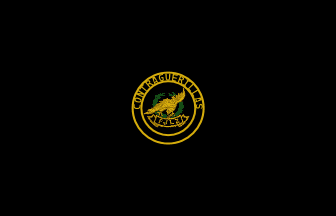
image by Eugene Ipavec, 21 February 2006
Image is based on pictures taken during the demobilization
ceremony of the Autodefensas Campesinas del Magdalena Medio
(ACMM) or Peasant Self-Defense of Middle Magdalena. They are
called like that because they are located mainly along the stream
of the Magdalena River, operating basically on the borders of the
Departments of Antioqiua, Boyacá and Santander. The ACMM
comprises six fractions (fronts) and the flag shown is the flag
of the founding front, the Frente José Luis Zuluaga (José Luis
Zuluaga Front). The ACMM belong to the AUC, the confederation of
paramilitary groups in Colombia. The flag is on black background
charged with the Coat of Arms.
Sources: Alto
Comisionado para la Paz website, CM& TV news of February
7th, 2006.
E.R., 21 February 2006

image by Eugene Ipavec, 2 August 2005
It is the flag of yet another AUC faction, called "Bloque
Héroes de Granada" (Heroes of Granada Bloc). It is named
after the Municipality of Granada, in the Department of
Antioquia. This group will lay down its weapons either tomorrow
or the day after, during another demobilization act under the
peace process between the AUC and the Colombian government. The
flag is the symbol over the Colombian flag. However the flag that
"should" come out has a proportion of 1:1 so it's more
of a banner (a square with the Colombian tricolour plus the
group's emblem on it in the middle). The faction's official
website is: <www.heroesdegranada.org>.
I saw this flag this past week during the troop concentration
prior to their disposal of arms on August. The flag has a peasant
raising his right arm (as the AUC is a far right armed movement)
and two crossed spears.
E.R., 1 August 2005
This group surrendered its weapons and all its rural and urban
structure, with a total of 2033 armed and unarmed
"personnel".
E.R., 2 August 2005

image by Eugene Ipavec, 5 July 2006
This is a paramilitary organization called Bloque Tolima
(Tolima Bloc), for being lcoated on the Department
of Tolima. It belonged to the ACCU (Autodefensas Campesinas
de Córdoba y Urabá), which at the same time belonged to the
much larger AUC (Autodefensas Unidas de Colombia). The Bloque
Tolima group laid down its weapons on October 22, 2005, and
during this ceremony a flag of the group can be seen. I assume
that the flag has the map of Colombia on the left, localetd
horizontally in the middle, and then the words
"TOLIMA".
Source: official website of the Alto Comisionado Para la
Paz <www.altocomisionadoparalapaz.gov.co>.
E.R., 23 December 2005

Flag with the old Coat of Arms
image by Eugene Ipavec, 24 July 2007
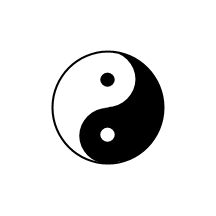
Flag with the new Coat of Arms
image by Eugene Ipavec, 24 July 2007
This is yet another faction of the AUC. It is called Bloque
Vencedores de Arauca (Arauca Victors Bloc) because it operates in
the Department of Arauca. It is a
"subbloc" of the Acbcb.
It had two Coat of Arms: the old one and the new one. This group
had the Coat of Arms on a white square background, and the flag
design is very similar to the Heroes of Granada
Bloc, which a plain square background (this time white
background only) charged with the Coat of Arms.
In the first Coat of Arms used by the group, an oil mill is seen
beucause the Department of Arauca has lenty of this mineral.
E.R., 24 July 2007
.gif)
logo
image by Eugene Ipavec, 3 November 2007
There is a movement called Jóvenes Fajardistas (Young
Fajardists), inspired by the Mayor of the City of Medellin Sergio Fajardo Valderrama, who
was in office from 2003 to 2007. This movement bears in its logo
the outlines of several people, which at the same time are party
members. These people are 21 youngsters between the ages of 18
and 32 who are aspiring to the City of Medellin's Council.
Source: Screenshot of blog website of Júvenes
Fajardistas, Official
website.
E.R., 3 November 2007
1) I saw two flags on
the online edition of the Colombian newspaper El
Espectador (The Spectator), dated Sunday, September 18, 2005.
They are related to an article regarding the crisis in Colombian
Labor Unions.
E.R., 19 September 2005
2) I found an article showing two unidentified flags used by
Colombian paramilitary forces (no specific faction though). The
article dates back to August 30, 2006 published by the newspaper El Colombiano.
The first photo shows a sitting combatant holding a plain white flag with an
udientified logo on it, in what seems to be a demobilization
ceremony of one of the paramilitary structures that composeed the
AUC.
The second unknown flag is
a black background rectangular-shaped flag, showing two guns in
plain white. This flag is shown at a protest rally held in an
unknown jail, possibly the High Security jail of Itagüí.
E.R., 1 October 2007